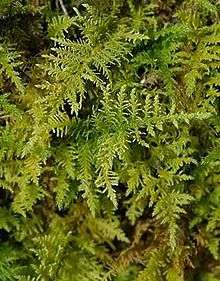Hypnales
| Hypnales | |
|---|---|
 | |
| Thuidium tamariscinum | |
| Scientific classification | |
| Kingdom: | Plantae |
| Division: | Bryophyta |
| Class: | Bryopsida |
| Subclass: | Bryidae |
| Order: | Hypnales W.R. Buck & Vitt, 1986 |
| Families | |
|
See Classification | |
Hypnales is the botanical name of an order of Bryophyta or leafy mosses. This group is sometimes called feather mosses, referring to their freely branched stems.[1] The order includes more than 40 families and more than 4,000 species, making them the largest order of mosses.[2][3]
Description

Hypnales are mosses with pinnately or irregularly branched, reclining stems, with varying appearances. The stem contains only a reduced central vascular bundle, which is seen as a recent derived trait in mosses. The stems are covered with paraphyllia or pseudoparaphyllia, reduced filamentous or scaly leaves.
The ordinary stem leaves are ovate to lanceolate, often with leaf wing cells. The midvein is often limited to the lower half of the leaf blade, or has completely disappeared. The cells of the leaf blade are prosenchymatic, many times longer than wide, with pointed ends interlocking.
The sporophyte consists of a regularly shaped sporangium on a long stalk or seta. The spores are distributed via a ring-shaped opening with two rows of teeth, the peristome, which before ripeness is closed by a beak-shaped operculum. The enlarged venter or calyptra is cap-shaped and smooth.[4][5]
Habitat, distribution and paleobiology
Hypnales are terrestrial, epiphytic or lithophytic plants that occur in the most diverse biotopes and are distributed worldwide. Many species of this family are not picky concerning their substrate and habitat. The earliest fossils of representatives of the Hypnales are known only from the Tertiary,[4] indicating that this group is young compared to other groups of mosses.
Classification
Recent genetic research suggests that the Fabroniaceae are the sistergroup of all other hypnales. Next to branch-off are the Catagoniaceae. According to this analysis, some of the remaining taxa may be polyphyletic (Lembophyllaceae, Neckeraceae, Brachytheciaceae), others paraphyletic (Lepyrodontaceae enclose Stereophyllaceae, part of the Brachytheciaceae enclose Symphyodontaceae and two separate parts of the Lembophyllaceae, part of the Neckeraceae enclose the remaining Brachytheciaceae, another part of the Lembophyllaceae enclose Rigodiaceae and Pterigynandraceae and a second part of the Neckeraceae). The rest of the families, the third part of the Neckeraceae and the fourth part of the Lembophyllaceae could be monophyletic.[6]
|
|
|
|
References
- ↑ Answers Corporation. "Hypnales:Information from Answers.com". Retrieved 1 December 2012.
- ↑ Goffinet, B.; W. R. Buck; A. J. Shaw (2008). "Morphology and Classification of the Bryophyta". In Bernard Goffinet & A. Jonathan Shaw (eds.). Bryophyte Biology (2nd ed.). Cambridge: Cambridge University Press. pp. 55–138. ISBN 978-0-521-87225-6.
- ↑ Goffinet, Bernard; William R. Buck (2004). "Systematics of the Bryophyta (Mosses): From molecules to a revised classification". Monographs in Systematic Botany. Molecular Systematics of Bryophytes. Missouri Botanical Garden Press. 98: 205–239. ISBN 1-930723-38-5.
- 1 2 The Global Biodiversity Information Facility (GBIF). "GBIF Checklist Bank: Hypnales". Retrieved 2 December 2012.
- ↑ Christopher Taylor. "FOS Variety of Life: Hypnales". Retrieved 2 December 2012.
- ↑ Merget, Benjamin; Wolf, Matthias (2010). "A molecular phylogeny of Hypnales (Bryophyta) inferred from ITS2 sequence-structure data". BMC Research Notes. 3: 320. doi:10.1186/1756-0500-3-320.
External links
| Wikispecies has information related to: Hypnales |